FALLOUT OF THE WENZHOU HIGH-SPEED TRAIN CRASH

rescue of toddler 21 hours
after the Wenzhou train crash Evan Osnos wrote in The New Yorker: “The Wenzhou crash killed forty people and injured a hundred and ninety-two. For reasons both practical and symbolic, the government was desperate to get trains running again, and within twenty-four hours it declared the line back in business. The Department of Propaganda ordered editors to give the crash as little attention as possible. “Do not question, do not elaborate,” it warned, on an internal notice. When newspapers came out the next morning, China’s first high-speed train wreck was not on the front page. [Source: Evan Osnos, The New Yorker, October 22, 2013]
“But, instead of moving on, the public wanted to know what had happened, and why. This was not a bus plunging off a road in a provincial outpost; it was dozens of men and women dying on one of the nation’s proudest achievements—in a newly wired age, when passengers had cell phones and witnesses and critics finally had the tools to humiliate the propagandists.
“People demanded to know why a two-year-old survivor was found in the wreckage after rescuers had called off the search. A railway spokesman said it was “a miracle.” Critics jeered, calling his explanation an “insult to the intelligence of the Chinese people.” At one point, the authorities dug a hole and buried part of the ruined train, saying they needed firm ground for recovery efforts. When reporters accused them of trying to thwart an investigation, a hapless spokesman replied, “Whether or not you believe it, I believe it,” a phrase that took flight on the Internet as an emblem of the government’s vanishing credibility. (The train was exhumed. The spokesman was relieved of his duties and was last seen working in Poland.
“Within days, the state-owned company that produced the signal box apologized for mistakes in its design. But to many in China the focus on a single broken part overlooked the likely role of a deeper problem underlying China’s rise: a pervasive corruption and moral disregard that had already led to milk tainted by chemicals reaching the market, and shoddy bridges and highways built hastily in order to meet political targets. A host on state television, Qiu Qiming, became the unlikely voice of the moment when he broke away from his script to ask, on the air, “Can we drink a glass of milk that is safe? Can we stay in an apartment that will not fall apart? Can we travel roads in our cities that will not collapse?”
“Prime Minister Wen Jiabao had no choice but to visit the crash site and vow to investigate. “If corruption was found behind this, we must handle it according to law, and we will not be lenient,” he said. “Only in this way can we be fair to those who have died.” People didn’t forget Wen’s pledge as the first deadline for the investigation came and went, and they continued to demand a fuller accounting. At last, in December, authorities released an unprecedented, detailed report. It acknowledged “serious design flaws,” a “neglect of safety management,” and problems in bidding and testing. It also blamed fifty-four people in government and industry, beginning with Great Leap Liu. The Minister’s name became a byword for “a broken system,” as the muckraking magazine Caixin called the Railway Ministry, a testament to the political reality that, as Caixin put it, “since absolute power corrupts absolutely, the key to curbing graft is limiting power.” When I spoke to an engineer who worked on the railway’s construction, he told me, “I can’t pinpoint which step was neglected or what didn’t get enough time, because the whole process was compressed, from beginning to end.” He added, “There is an expression in Chinese: when you take too great a leap, you can tear your balls.”
HIGH-SPEED TRAINS IN CHINA factsanddetails.com ; PROBLEMS WITH CHINA'S HIGH-SPEED TRAINS: HIGH COSTS, SAFETY ISSUES AND CORRUPTION factsanddetails.com ; SHANGHAI SUBWAY COLLISION AND OTHER TRAIN ACCIDENTS IN CHINA factsanddetails.com ; WENZHOU HIGH SPEED TRAIN CRASH IN 2011 factsanddetails.com
RECOMMENDED BOOKS: “China's High-Speed Rail Development” by Martha Lawrence, Richard Bullock, et al. | Jun 30, 2019 Amazon.com; “Handbook on Transport and Urban Transformation in China” by Chia-Lin Chen, Haixiao Pan, et al. Amazon.com; “China's Great Train: Beijing's Drive West and the Campaign to Remake Tibet” by Abrahm Lustgarten Amazon.com; “Taking the Train to Tibet” by Chen Yang | Amazon.com; “Riding the Iron Rooster: By Train Through China” by Paul Theroux Amazon.com; “The Last Steam Railways: Volume 1: The People's Republic of China” by Robert D. Turner Amazon.com; “English-Chinese and Chinese-English Glossary of Transportation Terms: Highways and Railroads” by Rongfang (Rachel) Liu and Eva Lerner-Lam Amazon.com; Lonely Planet China" 16 Amazon.com
Public Response to the Wenzhou High-speed Train Crash
“The accident caused much public anger and came to be seen as emblematic of the problems with China's breakneck development over the past three decades, sometimes achieved at the expense of public safety,” AP reported. “Public ire has been focused on the Railways Ministry, which has long functioned as a government within a government, operating its own police force and courts and incubating a culture of privilege and corruption.
Media and online commentators have questioned the official explanation of the accident and called for an independent investigation excluding ministry experts. Victims' families have complained that ministry officials have only discussed compensation while avoiding the issue of responsibility.
Newspapers questioned the official account and conspiracy theories dominated Chinese social media sites. Efforts by the propaganda department to bar Chinese media from questioning official accounts of the accident fuelled the anger and suspicion, especially about the death toll and rescue efforts. Many members of the public suspected officials had covered up facts and restricted media coverage of the accident to protect an ambitious rail expansion plan and the Communist Party's image of unruffled control.
Crash Victims and Their Families

rescue and search after
the Wenzhou train crash More than 100 relatives of victims protested at the Wenzhou South station, demanding to know the truth about what happened, according to the Global Times, an English-language newspaper affiliated with People’s Daily, the Communist Party’s official paper. At the protest at the train station, relatives held up a banner nearly 50 feet long that read: “Disclose the true reason behind the July 23 train crash and respect the dignity of victims,” the Global Times reported.
The Global Times, a tabloid owned by Communist Party mouthpiece the People's Daily, said the protesters demanded direct talks with officials from the Railways Ministry."They claimed that the bullet trains were built with advanced technology. How could lightning paralyze them so easily?" the newspaper quoted Wang Hui, whose husband died in the accident, as saying. The newspaper showed photographs on its website of dozens of people with some holding a banner that said: "Disclose the true reason behind the July 23 train crash and respect the dignity of victims."
Wang Hui’s husband, Zheng Hangzheng never made it home from a business trip on July 23, Bloomberg reported. Zheng left that night, Wang says. Instead of driving, as he usually did, he opted to take the bullet train. Four days later, Zheng called his wife, who was attending a wedding with their 17-month-old daughter Tangtang, to say he was heading home. His seat was near the back of the last-but-one car, the ticket found on his body showed.[Source: Bloomberg News, September 18, 2011]
At about 8:40 p.m., Wang remembers, Tangtang started screaming and crying. They had to leave the wedding early. What she didn’t know was that 10 minutes earlier, another train, traveling more than 100 kilometers per hour, slammed into Zheng’s train. The impact knocked three rail cars off a viaduct and another hanging over the side. On her way home from the wedding, Wang got a call from the family of a friend who was traveling with Zheng informing her of the collision. The friend had tried to find Zheng in the chaos but couldn?t. Wang says she tried Zheng’s phone. No answer. He probably lost his phone in the accident, she remembers thinking.
Early on July 25, Wang was driven by relatives to Wenzhou. When they reached the highway exit, she received a call telling her to go to the morgue not a hospital, as she had believed. "It felt like the sky collapsed on me," Wang says. When she collected his body, there was one thing missing: Zheng’s silver Audemars Piguet wristwatch. He’d planned to give it to Tangtang when she got older. Only a mark remained on the wrist where it was, Wang says. The police told her it must have been lost in the crash, she says. She thinks it was stolen. "When my daughter grows up, what can I say to her?" Wang says. "Her dad is gone. Just like that. Leaving her nothing but a watch, which nobody knows who took."
Since the accident, Tangtang has become clingy and likes to open her parents’ wedding album, Wang says. When she sees her daddy’s picture, she kisses it. Wang kept her husband’s last train ticket. "It feels as if he’s still on a business trip," she says. On Aug. 22, a day before the one-month anniversary of Zheng’s death, the widow commemorated his 35th birthday. She bought him some new clothes.
Compensation for the Families of Crash Victims
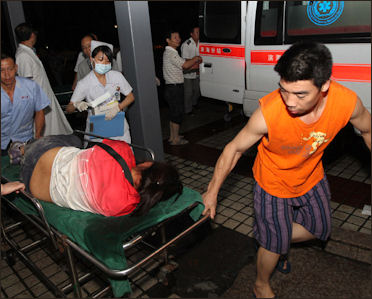
rescue and search after
the Wenzhou train crash Wang Hui, 32, said 10 days after the crash, authorities offered her 915,000 yuan ($143,000) to give up any claims against the Ministry of Railways. She says they hinted that if she didn’t agree, they would let Zheng’s body rot. She signed. Officials said compensation offered to families for relatives killed in the crash would rise to 915,000 yuan ($142,000) for each victim, almost double the 500,000 yuan initially proposed, the Xinhua news agency reported. [Source: Bloomberg News, September 18, 2011]
Bloomberg reported: For all her discontent, Wang Hui accepted the compensation offer after she was repeatedly visited by unidentified officials. On Aug. 2, one group came to her hotel in Wenzhou to offer condolences and muttered audibly about potential problems with her husband’s body because it wasn’t refrigerated, she says. "I felt that I had done things that hurt my husband," she says, tears rolling down her cheeks. "As if I were the one discussing compensation using his body."
There was no choice but to sign, she says. Huang Leping, a Beijing attorney Wang had consulted, said she had little chance of winning if she sued the ministry.Victims in such cases are often helpless because China’s courts may not hear the cases and lawyers are warned away from representing them, says Jerome Cohen, a professor of law at New York University who specializes in China legal issues. Those who continue to protest for greater justice also risk recriminations. Zhao Lianhai, whose son was poisoned by milk contaminated with melamine, was jailed after he tried to organize other parents to campaign. He’s since been freed. Wang says she just wanted to ensure her husband was cremated so she could take his ashes back home.
Wang said she doesn’t care about the money. She wants to know why her husband was killed in the crash. "It was too early to discuss compensation when the truth of the accident and who was responsible were unknown," Wang said. A video of Wang asking for justice in an interview at Wenzhou train station went viral after being posted on two of the country’s biggest video- sharing websites, and 127,000 followers now read her microblogs on a Chinese version of Twitter. [Source: Bloomberg News, September 18, 2011]
Wan used the Internet to voice her disgust. "I will never accept the railway ministry’s apology," she wrote Aug. 12 to her followers on weibo, the Chinese name for microblogs. "When we have the truth, my husband’s soul can rest and the whole family can have a little comfort," Wang says from her home in Lianjiang in Fuzhou, 368 miles (592 kilometers) south of Shanghai. "Give us some guarantee that the lives of ordinary Chinese are safe."
Weibos amd the Internet Response to the Wenzhou High-Speed Train Crash
Chinese flooded Internet bulletin boards, video-sharing sites and microblogging sites with their outrage over the handling of the train crash and furious complaints about breakneck development without heed to safety. Many also expressed fears of a cover-up, especially after reports that one train car was buried at the site despite the ongoing investigation and only later excavated. Some members of the public questioned the official death toll.
Journalists posted images online of newspaper pages that were spiked because of the government directive. They were later deleted. Whether this outpouring of anger will result in greater transparency from the government or a tighter crackdown is an open question, says Elizabeth C. Economy, director for Asia Studies at the Council on Foreign Relations in New York. "Does all the chatter build to critical mass?" Economy says. "I’m a firm believer that the day will come." [Source: Bloomberg News, September 18, 2011]
A key factor behind the outburst of criticism against the government was a Chinese version of Twitter called weibo that is reportedly used by 170 million people. Large volume of information about the railway disaster was disseminated by these microblogs despite censorship by the authorities. Michael Wines and Sharon Lafraniere wrote in the New York Times, “An astounding 26 million messages on the tragedy, including some that have forced embarrassed officials to reverse themselves, had been posted within five days after the tragedy. They were expressions of contempt for railway authorities and suspicion of government explanations. [Source: Michael Wines and Sharon Lafraniere, New York Times, July 28, 2011]
The New York Times reported, “As state television devoted Saturday evening to reports of mass murder in Norway, Sina Weibo weighed in four minutes after the train accident with a post from the crash scene, by a passenger reporting a power blackout and “two strong collisions.” Nine minutes later, another passenger posted a call for help, reposted 100,000 times: “Children are crying all over the train car! Not a single attendant here!” Two hours later, a call for blood quickly clogged local hospitals with donors. A Sina Weibo post by a girl who saw the rammed train train shortly before it was hit from behind read: “After all the wind and storm, what’s going on with the high-speed train? “It’s crawling slower than a snail. I hope nothing happens to it.”
Then the reaction began to pour in. “Such a major accident, how could it be attributed to weather and technical reasons?” blogged Cai Qi, a senior Zhejiang Province official. “Who should take the responsibility? The railway department should think hard in this time of pain and learn a good lesson from this.” From a Hubei Province blogger: “I just watched the news on the train crash in Wenzhou, but I feel like I still don’t even know what happened. Nothing is reliable anymore. I feel like I can’t even believe the weather forecast. Is there anything that we can still trust?”
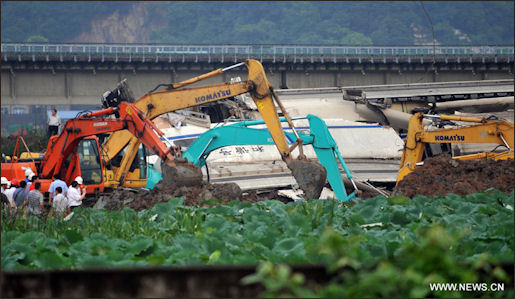
burying the train carriage after the Wenzhou train crash
Impact and Implications of the Wenzhou Train Crash Weibos
Michael Wines and Sharon Lafraniere wrote in the New York Times, “While the blogs have exposed wrongdoers and broken news before, this week’s performance may signal the arrival of weibos as a social force to be reckoned with, even in the face of government efforts to rein in the Internet’s influence. [Source: Michael Wines and Sharon Lafraniere, New York Times, July 28, 2011]
The government censors assigned to monitor public opinion have let most, though hardly all of the weibo posts stream onto the Web unimpeded. But many experts say they are riding a tiger. For the very nature of weibo posts, which spread faster than censors can react, makes weibos beyond easy control. And their mushrooming popularity makes controlling them a delicate matter.
Chinese government issued instructions to domestic media, prohibiting reproduction of weibo messages or covering the story on their own. Media were ordered only to use articles released by the state-run Xinhua News Agency. Some media did not comply with these instructions. Weibo users were able to sidestep the government media completely. This phenomenon has never been seen on this scale before.
There is no clearer sign of the rising influence of microblogs than their impact on government itself. Wenzhou bureaucrats, for example, ordered local lawyers not to accept cases from families of victims without their permission. After weibos exposed them, they withdrew the order and apologized.
“I call it the microblogging revolution,” Zhan Jiang, a professor of international journalism and communications at Beijing Foreign Studies University, told the New York Times. “In the last year, microbloggers, especially Sina and Tencent, have played more and more a major role in coverage, especially breaking news.” The few newspapers and magazines here that consistently push back at censors with investigative journalism are not just printing the results of their digging into the train wreck, but posting them on weibos for millions to see. So were hundreds of more traditional state-controlled news outlets.
What’s different this time is the public scrutiny on weibo meant the government "lost control of the story line," Patrick Chovanec, a professor at Tsinghua University’s School of Economics and Management in Beijing, told Bloomberg. "The crash isn’t the problem as much as the government’s response, which is seen to be patronizing and not credible," he says. "People just weren’t buying it."[Source: Bloomberg News, September 18, 2011]
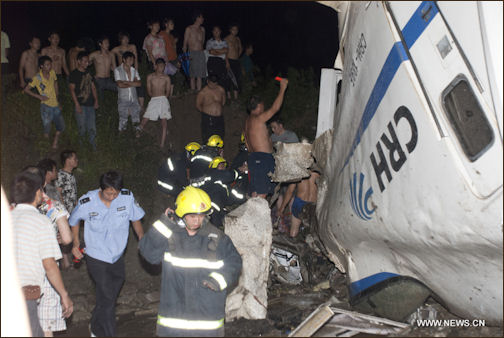
rescue and search after the Wenzhou train crash
Chinese Government Response to Public Outrage Over the Wenzhou Train Crash
Ten days after the crash, according to AP, Chinese leaders called for more openness in government in the wake of widespread public anger at authorities over the lack of transparency in handling the accident. Chinese state media published a circular from the Cabinet calling for more government openness, saying that departments should publicize in detail their expenditures and data on major construction projects. "Local government departments must make more efforts to ensure transparency in government affairs in order to protect the people's rights to know about and supervise the government," the circular said. [Source: Associated Press, August 3, 2011]
The notice published on the front page of the People's Daily did not mention the July 23 train crash. But it said that information on major emergencies and topics of widespread interest should be made public "objectively" and in a timely way. This includes the results of investigations, official measures to deal with the emergencies and preventive efforts, the notice said.
When Premier Wen Jiabao visited the accident site a few days after the crash he promised the government would issue a report to "get to the bottom" of what happened. After the uproar over the buried carriages the railway ministry was taken off the case. The State Administration of Work Safety, which reports to the State Council, or Cabinet, was put in charge of a full probe, according to Xinhua. The government also fired three officials, including the head of the regional rail bureau, and started a two-month review of railway safety.
The accidents prompted month-long inspections of dozens of projects and 3,700 miles (6,000km) of bullet train lines. Sheng Guangzu, who became rail minister in February 2011, pledged to ensure the “absolute” safety of high- speed railways by improving the quality of equipment, management and training, according to a statement posted on the ministry’s website yesterday.
Although the railways are rushing to fix the faulty systems, some experts believe train services should be stopped until all the problems are fixed, the Daily News reported. It cited an unnamed expert saying that the crash occurred because of an unusually heavy lightning storm and that the signals should normally work. Whether they would be replaced would depend on a variety of factors, including cost, it said."There were also many problems with management and co-ordination and some of the workers are not well qualified," the Daily News cited the report as saying. However, assigning responsibility for the mismanagement is proving controversial, it added.
Huang Yi, a spokesman for the State Administration of Work Safety, told the state-run Xinhua News Agency in late August the Wenzhou crash "could have been avoided and prevented." Huang Liu Lianguang, a professor at North China Electric Power University who was a member of the investigative panel, said Sept. 16 it had found signal software problems and human error contributed to the crash.
Public Demands for Accountability, Credibility and Safety
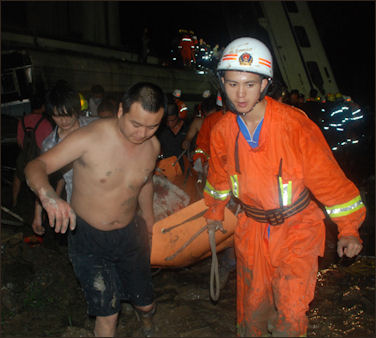
rescue and search after
the Wenzhou train crash The Wenzhou train crash had repercussions that went far beyond the train crash itself. "Economic growth is increasingly not enough," Cheng Li, a senior fellow at the Brookings Institution in Washington, told Bloomberg . "The Chinese people are saying that their government proved it can deliver development, now it should deliver accountability." That so many Chinese are reassessing the costs of the country’s economic growth, which averaged more than 10 percent annually over the last decade, poses one of the stickiest challenges for one-party rulers in the years ahead: balancing a drive for wealth with the public satisfaction necessary for social stability. [Source: Bloomberg News, September 18, 2011]
Some members of the public still question the official death toll. Hua Xinmin, whose grandfather was a prominent Chinese railway engineer, is collecting the names of riders in six of the most damaged rail cars to determine if the government’s accounting is accurate. Her weibo posts were forwarded 10,000 times before being stopped by the service provider. "This is about the dignity of each life and a safe tomorrow," Hua, a French citizen living in Beijing, says. "What’s at stake is the credibility of the government."
The event seemed to resonate especially strong with China’s growing middle class, computer-savvy, able to afford travel by high-speed rail, already deeply skeptical of official propaganda. Andrew Wedeman of the University of Nebraska-Lincoln told Bloomberg the outrage over the crash has a very middle class tone to it, . "They’re angry about the quality of the train and the cover-up," he said. "China’s professionals, the beneficiaries of reform, who should be rock solid in their support for the regime, are beginning to question the ability of the government to furnish a better life."
China Admits Flaws and Blames 54 Officials for the Wenzhou Train Crash
In mid August, according to an AFP report, China's railways ministry acknowledged flaws in the construction of its high-speed rail links. According to the state-run People's Railway Daily newspaper, the ministry acknowledged earlier this week that "flaws exist in the management of construction of high-speed railways...Some units have not paid enough attention to key operations involving the safety of high-speed rail links." A week earlier state media said investigations into the crash had determined it was "completely avoidable", adding that design defects had likely caused equipment failures and emergency plans were also deficient. An official quoted in the Economic Weekly said: "In reference to the possibility of human error,"it's no secret within the organization that railway signals don't respond properly during emergencies. The official on duty should have used wireless communication to inform the conductors of the situation." [Source: AFP, 16 August 2011]
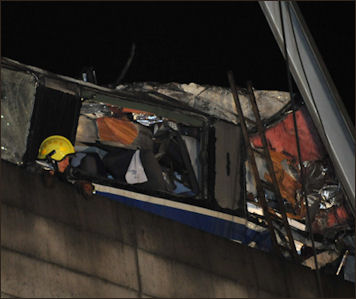
rescue and search after
the Wenzhou train crash In December 2012, AP reported: “A long-awaited government report said design flaws and sloppy management caused a bullet train crash in July that killed 40 people and triggered a public outcry over the dangers of China's showcase transportation system. A former railway minister was among 54 officials found responsible for the crash, a Cabinet statement. Several were ordered dismissed from Communist Party posts but there was no word of possible criminal penalties. The crash report was highly anticipated. Regulations had required the report to be released by Nov. 20. When that date passed, the government offered little explanation, drawing renewed criticism by state media, which have been unusually skeptical about the handling of the accident and the investigation. [Source: AP, December 28, 2011]
The government said that design flaws and mismanagement caused the July 23rd crash The Cabinet statement cited "serious design flaws and major safety risks" and what it said were a string of errors in equipment procurement and management. It also criticized the Railways Ministry's rescue efforts. The report affirmed earlier government statements that a lightning strike caused one bullet train to stall and then a sensor failure and missteps by train controllers allowed a second train to keep moving on the same track and slam into it.
Those singled out for blame included former Minister of Railways Liu Zhijun, a bullet train booster who was detained in February amid a graft investigation. Also criticized was the general manager of the company that manufactured the signal, who died of a heart attack while talking to investigators in August. The decision to assign blame to one figure who already has been jailed and another who is dead, along with mid-level managers who have been fired, suggests further political fallout will be limited. Several officials including a former Communist Party secretary of the Shanghai Railway Bureau were ordered dismissed from their party posts, a penalty that is likely to end their career advancement. Others received official reprimands but there was no mention of possible criminal charges.
Chinese Internet users accused the government of failing to take responsibility for a deadly bullet train crash, AP reported, after it said 54 officials were to blame but none would face criminal charges. "It looks like they found some scapegoats to fire," said a note posted on Weibo. Thousands of postings on microblogs and Internet bulletin boards criticized the penalties as too mild. They said too few senior figures were held accountable for the disaster near the city of Wenzhou. Before the crash, the bullet train network enjoyed support from Communist Party leaders and a political status on par with China's manned space program. Since then, Chinese leaders have distanced themselves from it, scaling back expansion plans for the multibillion-dollar bullet train and overall construction spending on China's rail network, the world's largest. [Source: AP, December 29, 2011]
Slowing the Construction of High-Speed Trains After the Wenzhou Crash

Three weeks after the crash the Chinese government said it was suspending approval of all new railway construction projects. The government now may slow that plan by as much as a year, said Karen Li, a JPMorgan Chase & Co. analyst in Hong Kong, told Bloomberg. During a visit to the crash site near Wenzhou in southeast China, Wen said the industry needed to place more emphasis on safety rather than expansion. [Source: Bloomberg News, September 18, 2011]
After the accident, Bloomberg reported, the rail ministry has suspended approvals on new projects nationwide, recalled 54 high-speed trains and removed three top regional railway officials from their posts."The accident is a blow to government’s ambition to attain world class technology for the country," says Nicholas Yeo, the Hong Kong-based head of China and Hong Kong equities at Aberdeen Asset Management, who oversees $70 billion. "It points to the country focusing on speed at the compromise of quality."
The crash bruised the reputation of the rail industry at the heart of China’s plans to spread prosperity inland and provide exports more sophisticated than consumer goods. The high-speed network -- dubbed Harmony after the regime’s goal to create a prosperous, "harmonious society" -- opened in 2007 and was slated to be the world’s biggest network at 16,000 kilometers (9,900 miles) by 2015.
In October 2011, Reuters reported that China has postponed the building of 80 percent of new railway projects pending clarification of government policies for the sector. "At present, more than 80 percent of ongoing railway construction projects have been suspended, and the completion of many projects has been pushed back by a year," the 21st Century Business Herald newspaper said. China has also temporarily stopped all plans with foreign companies to build high-speed railways abroad, the newspaper cited another person who attended a recent high-level meeting as saying. [Source: Reuters, October 1, 2011]
The government said it would suspend new railway project approvals and launch safety checks on existing equipment to address public anger following a crash on a new high-speed rail line in July which killed 40 people. The Railway Ministry is facing a high debt burden too. It said in August that its total liabilities at the end of June were 2.1 trillion yuan ($329 billion), up by nearly half from the end of 2009 and bringing its liability-to-asset ratio up to 59 percent. "Almost all banks have stopped lending for railway construction," the newspaper cited an unnamed source close to the Railway Ministry as saying. "There is no decision yet on the next move for China's high-speed railways."
Recalled Trains, Slower Train Speeds and Measures Taken After the High Speed Train Crash
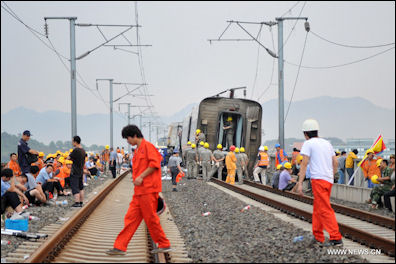 After the crash the Chinese government said ordered the maximum speed of trains on the newly-built lines to be lowered by as much as 20 percent. In late August, China.org reported, began rescheduling trains to run at slower speeds over safety concerns. The rescheduled plan involves 498 trains and major rail lines such as Beijing-Harbin, Beijing-Guangzhou, Beijing-Shanghai and Lianyungang-Lanzhou lines, according to the Ministry of Railways (MOR).
After the crash the Chinese government said ordered the maximum speed of trains on the newly-built lines to be lowered by as much as 20 percent. In late August, China.org reported, began rescheduling trains to run at slower speeds over safety concerns. The rescheduled plan involves 498 trains and major rail lines such as Beijing-Harbin, Beijing-Guangzhou, Beijing-Shanghai and Lianyungang-Lanzhou lines, according to the Ministry of Railways (MOR).
Earlier in August high-speed trains traveling between Beijing and Tianjin and between Shanghai and Hangzhou had their speeds reduced to 300 km per hour, down from 350 km per hour. After the late August readjustments, lines that had been trains running at 250 km per hour, reduced speeds to 200 km per hour. These lines included the ones between Hefei and Nanjing, Hefei and Wuhan, Shijiazhuang and Taiyuan and other lines. CRH trains that ran at 200 km per hour were slowed to 160 km per hour, it added.
In late August 2011, the New York Times reported, one of China’s high-speed train manufacturers, the CNR Corporation, announced that it was recalling 54 of its trains from the Beijing to Shanghai route to test sensors that may be causing the trains to stop unnecessarily, such as when a passenger lights a cigarette in a restroom. The Rail Ministry announced separately that the number of high-speed trains each day between Beijing and Shanghai would be reduced to 66 in each direction, from 88 in each direction now. The moves, coming after the government announced a safety review of high-speed rail, seemed to reflect heightened concern after a deadly high-speed rail crash last month. [Source:Keith Bradsher, New York Times, August 12, 2011]
China's government has said it will reduce its train fares by five percent, in a move believed to be aimed at attracting commuters back to the country's beleaguered rail system.
In late November 2011, Reuters reported: China will put back into service 54 bullet trains that were recalled after a deadly train crash in eastern China fanned a furore about equipment flaws, state media said on Thursday. The recalled trains, which were meant to be used on the flagship Beijing-Shanghai high-speed rail line, had undergone 'rigorous modifications and testing', state news agency Xinhua said, without elaborating. The trains were recalled by China's second-biggest train maker China CNR Corp Ltd in August, three weeks after the Wenzhou accident. [Source: Reuters, Dec 1, 2011]
Political Implications of the High Speed Train Crash
According to the Economist: “In their unprecedented anger over the crash and its handling, ordinary Chinese and the state media have, amazingly, suddenly found common cause against the government. China has nearly 500 million internet users. On Twitter-like microblogging sites, criticisms spread so quickly that censors could not keep up. Even the state-controlled media sharply questioned official explanations for the crash and criticised the government’s response to the accident. On July 29th, when the openness threatened to get out of hand, the censors ordered an end to it, but even then some state publications defied orders. Mao Zedong said that a single spark could start a prairie fire. The capacity of both journalists and the public to speak up in huge numbers has breached a firebreak not crossed since the Tiananmen protests in the pre-internet age. [Source: The Economist, August 6, 2011]
“China’s rulers love to point out the shortcomings of Western-style democracies; the “Beijing model” by contrast gets difficult jobs done. That view is often echoed by Western businesspeople. Yet breakneck economic development has cut corners, distorted priorities and created big conflicts of interest. The railways ministry is manufacturer, operator and regulator of the network. Now ordinary Chinese folk are questioning their country’s less-than-triple-A politics. A hurtling train is a metaphor for runaway development that is generating its share of collapsing buildings, lethal coal mines and bulldozed neighbourhoods. By contrast, Japan’s bullet train has had just one fatality in 47 years, a passenger caught in a door.
“China’s technocrats managed to fix its once faulty airlines. But the issue at Wenzhou is not really the rushed engineering. Rather it is the growing need, in an increasingly complex country, for scrutiny, accountability and public debate. It has, in other words, shown the limits of dictatorship. Some of China’s rulers probably know that — but, to judge by the news crackdown now under way, clearly not enough of them.”
Image Sources: Xinhua
Text Sources: New York Times, Washington Post, Los Angeles Times, Times of London, The Guardian, National Geographic, The New Yorker, Time, Newsweek, Reuters, AP, Lonely Planet Guides, Compton’s Encyclopedia and various books and other publications.
Last updated July 2022
